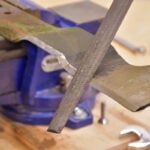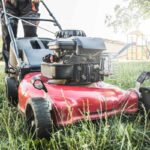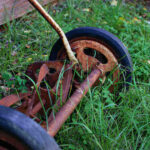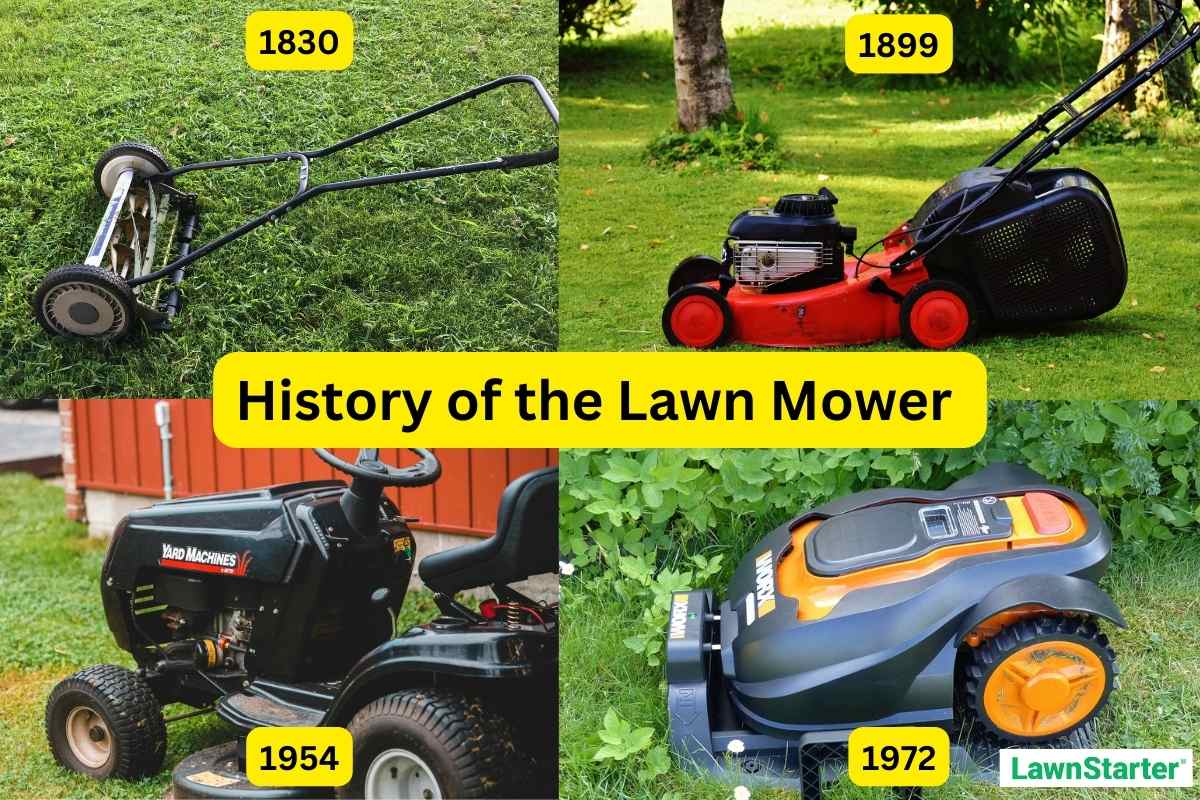
That lawn mower you use to cut your grass has been centuries in the making. Yes, really. The history of the lawn mower is really the history of cutting grass, and that starts with a scythe.
The sound of lawn mowing has changed over the centuries too, from the thwack of a scythe cutting blades of grass, to the roar of gas-powered riding lawn mowers, to the whisper of battery-powered and robot mowers.
Who invented the lawn mower? Edwin Budding is credited with inventing the first lawn mower in 1830. Budding’s reel lawn mower revolutionized lawn care in England and then the U.S. and the world. (You’ll read more about Budding in a moment.)
The history of the lawn mower includes a series of inventors who rolled out reel mowers, rotary mowers, self-propelled mowers, riding lawn mowers, and robot mowers. We’ll cover all that and much more below.

If you think pushing a lawn mower is tiresome, imagine wielding a scythe to keep your grass from growing out of control. Wielding a scythe was back-breaking but arm muscle-building work.
And the grass blades cut with a scythe were anything but even and trim. Even those skilled at handling a scythe would leave behind swirls or sear marks.
Another option? Animal mowing. Hungry livestock sometimes helped to keep grassy areas from growing out of control. Everything old is new again, and that includes animal mowing, which is trending again in some parts of the U.S.
Scythes and animal mowing – that’s how lawns were kept trim from around the 1100s till the 1800s in Great Britain and the early U.S.
There had to be a better way to cut grass.
The invention of push lawn mowers, which includes reel lawn mowers and more modern-looking rotary lawn mowers, made it easy – and much more affordable – for anyone to mow their lawn.
Reel Lawn Mowers
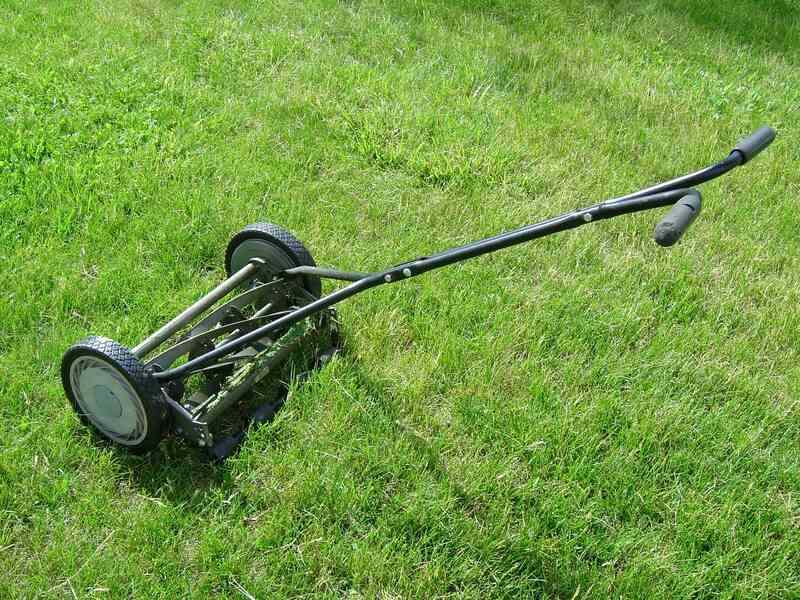
What is a reel lawn mower and how does it work? Reel lawn mowers are typically man-powered, with blades on a horizontal axis that cut like scissors. This scissors-like cut is healthier for the lawn.
1830: The reel lawn mower was invented by an Englishman, Edwin Beard Budding.
Budding received a patent for his invention that featured:
- A large roller. It was quite heavy.
- Gears and knives. These blades were based on ones used in textile mills to make the textiles be smooth.
- A cylinder that turned the gears and knives.
- A grass-catching tray. The grass was thrown forward, so the tray could be on the front.
The first purchasers of Budding’s invention included the London Zoo and Oxford University. Before long, Budding’s lawn mowers were used on the Royal Grounds.
1832: The Ransomes Co. purchased a license to manufacture Budding’s machine and began to sell “The Ransome New Automaton” models in cutting widths from 6 to 36 inches.
1842: Scotsman Alexander Shanks manufactures the first pony-drawn lawn mower. Similar horse- and pony-drawn lawn mowers remained in production until 1939. Not included in the price of the mower: leather boots to prevent hoofprints on the lawn.
1859: The first block chain mower (no, not that kind of blockchain…) was invented by Thomas Green and Sons of Leeds & London. The block chain design allowed for a quieter machine that was much lighter due to the absence of cast iron gears.
Green’s mower featured:
- Silens Messor (French for “silent operation”).
- Chains instead of gears, which is why it was quieter.
- A range of blade sizes (cutting width) from 6 to 48 inches.
- Horses pulled Green’s largest lawn mowers.
- A second person pulled the 14-inch, 16-inch, and 18-inch sizes. (It was better than having horse poop on your lawn.)
Green’s quieter lawn mower was hugely popular. More than a million were sold. The servants could mow the lawn without giving headaches to the lords and ladies on the porch.
1868: During the Civil War, Connecticut resident Amariah Hills spent the war years developing an American version of the lawn mower. His “lawn-mower,” as Hills called it, received a U.S. patent.
Hills’ lawn mower featured:
- A spiral cutter that was more efficient.
- An open cylinder chamber. (This makes it easier to check the operation of the lawn mower.)
- Height adjustment. Maybe the English wanted all their grass to be the same height, but Americans wanted to be able to mow grass at different heights. (This was a big advance, as the optimum height varies for different grass types.)
- A better handle. Hills’ lawn mower was designed to be used by one person (not pulled by a horse nor needing two people to push-pull the mower), so a smoother-operating handle mattered.
Hills sold the rights to his lawn mower to Caleb Talcott, who started making and selling the grass cutters in 1871.
Hills’ invention and Talcott’s business acumen soon would lose ground to the revolution of push lawn mowers (reel lawn mowers and rotary lawn mowers).
1870s: In Richmond, Indiana, Elmwood McGuire designs and manufactures what will become a commercially successful human-powered push mower.
1893: The Dille and McGuire Manufacturing Co. volunteer to cut all the grass at the 1893 Chicago World’s Exposition for free. Visitors, many of whom have never seen a lawn mower, witness a team of men using hand-powered grass cutters to maintain the green spaces at the expo.
Rotary Lawn Mowers
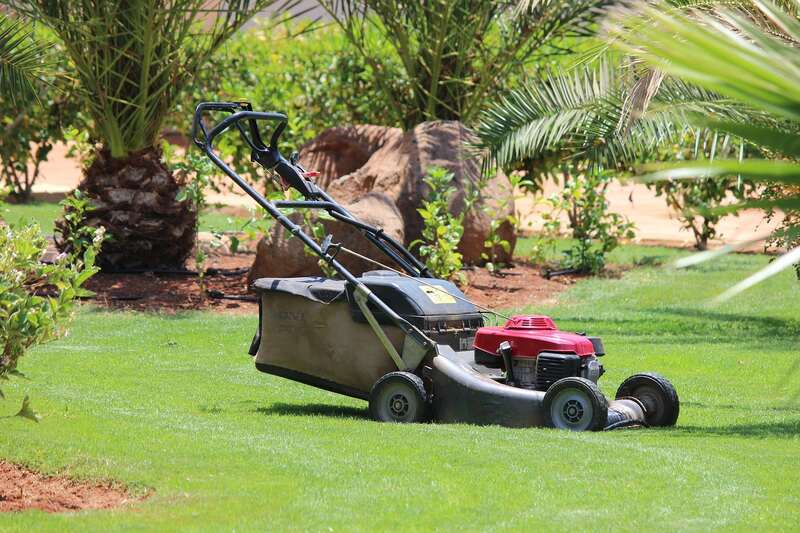
What is a rotary lawn mower and how does it work? A rotary lawn mower has rapidly rotating blades on a vertical axis, cutting grass to a pre-set, adjustable height. Rotary mowers can be gas-powered, corded-electric, or run on batteries (that will need to be recharged).
Rotary mowers may have a bag to collect grass clippings, or you can blow the cut grass onto your lawn for raking later.
Some rotary mowers are mulching mowers, which cut your grass and mulch the trimmings, saving you the effort of bagging your grass clippings, while also fertilizing your yard as you mow.
1899: John Albert Burr, an African-American, receives a U.S. patent for a rotary blade lawn mower. It makes him rich. Burr’s reel lawn mower has to be pushed.
1929: William Beazley patents in America a power rotary lawn mower. It creates a precise, short cut. But the engines are quite heavy.
1939: Leonard Goodall, a man with one leg, struggles to mow his large lawn in Warrensburg, Missouri. He develops a rotary power lawn mower, which he calls a “vertical crankshaft mower.” He receives a patent for it, and then additional patents in 1940, 1942, and 1946. His company makes him wealthy, especially when he sells it in 1952 (though he did not change his lifestyle).
1953: The first lightweight engines are mass produced (by Briggs & Stratton).
1957: 80% of the lawn mowers sold in the U.S. are rotary.
Gas-Powered Lawn Mowers
1902: Gas-powered lawn mowers become commercially available. Sold by Ransomes of Ipswich, these lawn mowers feature the newly developed internal combustion engine.
1919: Gas-powered lawn mowers are manufactured in the United States for the first time. Edwin George, who had just retired as an Army colonel, took the engine from his wife’s washing machine and put it on wheels.
1921: The first mass-produced gas lawn mower is manufactured by the Atco company.
But neither gas-powered lawn mower sold a lot, in large part because there weren’t that many places where you could get gas. People fueling their cars often had to buy their gasoline in cans at pharmacies and blacksmith shops.
In 1927, famed architect Frank Lloyd Wright proposed the building of “filling stations” across the country, stations that he just happened to have a design for. He found no backers.
Then came the Depression. People struggling to get by preferred to push their own mowers rather than buy gasoline.
After World War II, then came all those Levittowns. Americans moved to the suburbs in a great wave after World War II. Suburbia grew from 19.5% of the population in 1940 to 30.7% in 1960.
In the post-war years, as Americans moved to the suburbs, gas stations followed, and gas-powered mowers swept the nation.
1954: Toro takes the lead in the sale of power mowers.
Self-Propelled Mowers
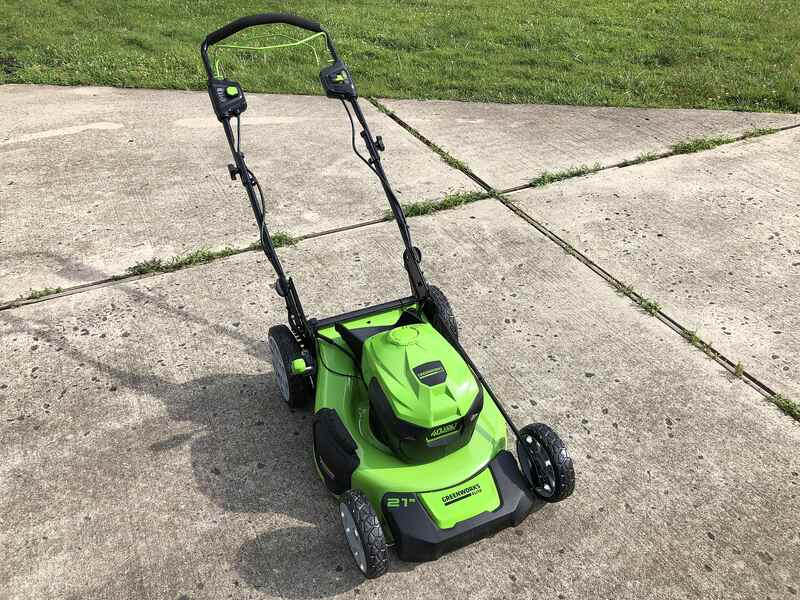
As lawn mowers moved from the tools of paid employees to the device used by homeowners (this is such an American concept; Americans took care of their own lawns, the English with lawns were people who had servants), there was a demand for something different.
Americans wanted a lawn mower that didn’t require horses or a steam engine … or your own pushing. They wanted a mower that motored on its own. All the person behind had to do was steer.
1922: The first self-propelled lawn mower was introduced by the Ideal Power Mower Co. But it didn’t catch on. In 1943, the company was sold.
SEE RELATED: What is a Self-Propelled Lawn Mower?
1954: The Bunton Co. of Louisville, Kentucky, developed a self-propelled lawn mower, one using the new technology of rotary blades. This time self-propelled mowers took off like a rocket.
1955: Sears Craftsman, the leading brand for self-propelled lawn mowers, had sold 1.5 million of the grass cutters.
By 1959, self-propelled were outselling the ones you push by 10-to-1.
Riding Lawn Mowers
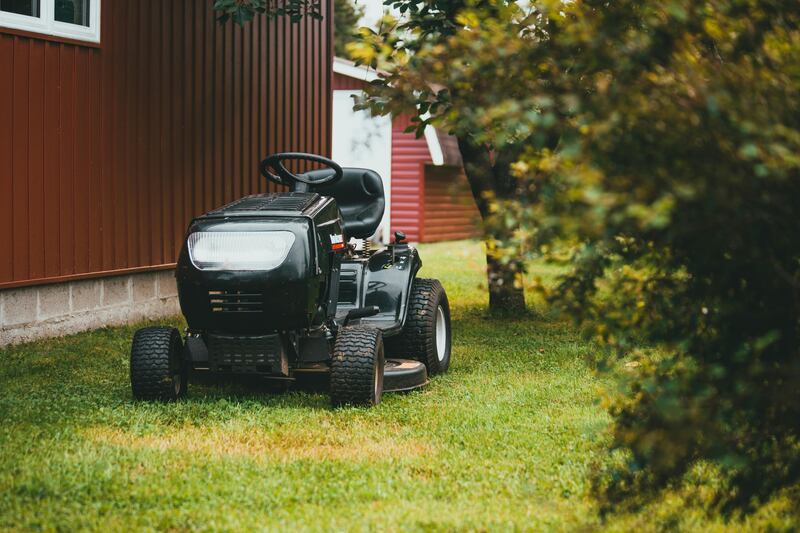
People moving to the suburbs wanted to care for their lawns in comfort. Riding lawn mowers made cutting the grass a breeze. (Talk about comfort: Standard features later would include cupholders.)
Ride-on mowers. Riding mowers go back so far they were originally known as “ride-on mowers.”
1870: Elwood McGuire received the patent for a lawn mower that was simpler, and therefore lighter. It was just right as a push mower for a simple yard.
But larger areas called for something that had a power source:
- Horses. But there was poop, and the hooves could tear up what you were creating to use for sports, parties, or playtime.
- Steam. Lawn mowers powered by steam engines started appearing in the 1890s. But they are slow, take time to get ready, and are so heavy they are likely to tear up the lawn.
It was said that it took longer to create the steam than it did to mow the lawn.
It also called for the operator to sit on the mower, making it the first riding mower. Some people put chairs on their mowers. Others would simply ride the horses.
But few of them sold.
1904: Ransomes does it again by developing the first gas riding lawn mower, which was sold to Cadbury Chocolates and Bournville House to maintain their employees’ sports field.
Early riding lawn mowers were heavy. A ride-on sold by Ransomes to maintain a sports field in Birmingham, England, weighed 1¼ tons and stretched 8 feet long.
1921: “World’s first riding lawn mower“ was an advertising campaign introduced by the Ideal Power Mower Co. in Fort Wayne, Indiana. It didn’t catch on.
1954: Cecil Pond hated mowing the lawn as a kid, so after he served in the war and married his high school sweetheart, he decided to make a riding lawn mower. He introduced it at the Chicago Trade Show, and it electrified the crowd. He started his own company, Wheel Horse, which couldn’t keep up with demand.
Meanwhile, Pond loved mowing lawns. He would not only mow his lawn, but also ride over to mow the lawns of his neighbors.
Lawn Tractors
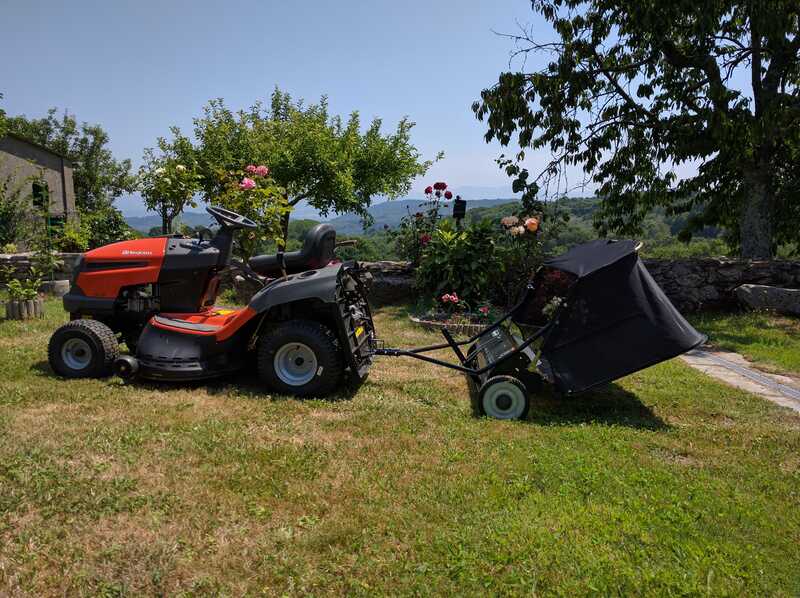
Many riding mowers are so heavy that they are designed to do other things. A “lawn tractor” is a common alternate usage. There are also forklifts, snow plows, snow blowers, rototillers, and leaf vacuums.
Riding mower rules of the road: You don’t need a driver’s license to operate a riding lawn mower – but only when you use it on private property. Take it on the street (say, to drive to a lawn-mowing job) and you need a license.
People who have had their driver’s license suspended are known to try to instead drive their lawn mower to get around. That doesn’t work: The mower might be legal, but the driver isn’t, in that case. Expect tickets, or even arrest.
And DUI applies to lawn mowing, too. Maybe DUI should be called MUI? Each year there are dozens of people arrested for mowing while under the influence.
Pro Tip: Keep only alcohol-free drinks in your riding mower’s cup holder. Don’t drink St. Arnold’s Lawn Mower Beer – or any beer – while you’re operating your John Deere or Cub Cadet.
Zero-Turn Mowers
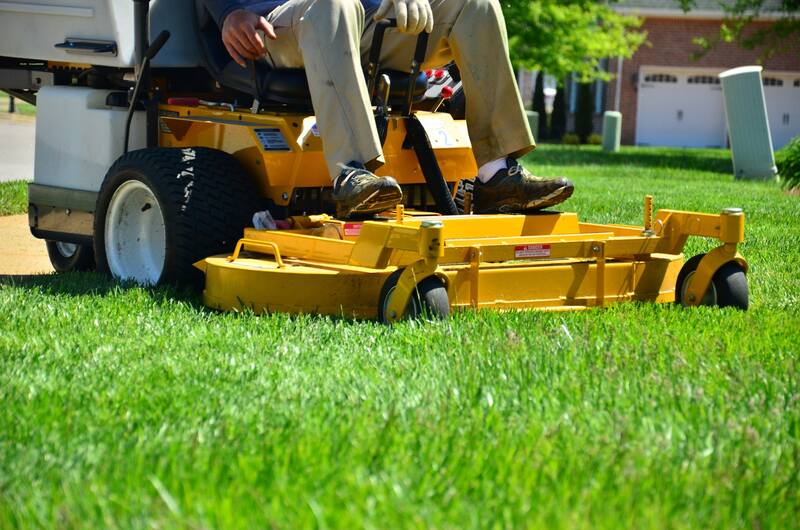
1955: Max Booth Swisher of Warrensburg, Missouri, rolls out the “Ride King,” the first zero-turn lawn mower. Key features of the Ride King:
- 360-degree changes were possible.
- Front wheel was the drive wheel.
- The motor drove the front wheel in the direction the operator wanted to go.
- The steering wheel could be turned all the way to reverse.
Zero-turn mowers are hugely popular for large lawns and with commercial lawn care companies. The ability to turn on a dime, so to speak, makes it much easier and quicker to mow lawns. More lawns mowed equals more money earned.
Battery and Electric Lawn Mowers
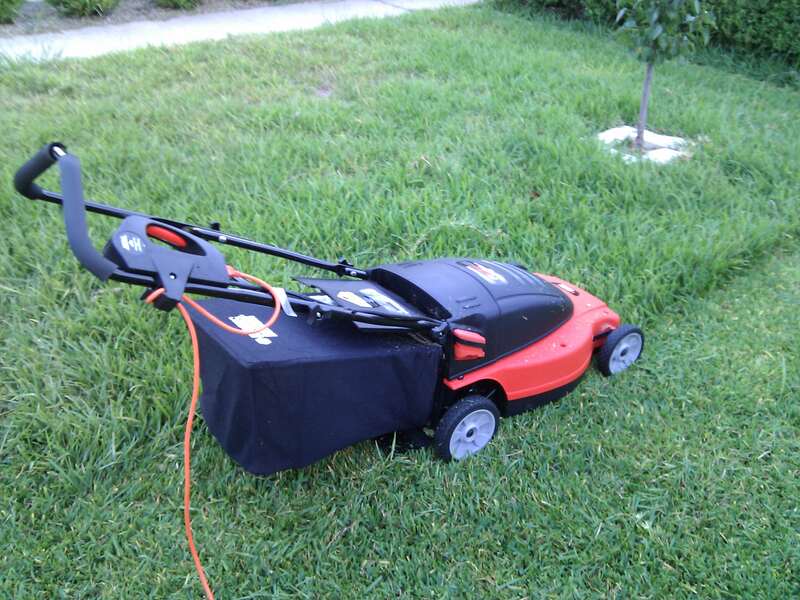
Electric corded and battery-powered lawn mowers are becoming more common. Here’s why: They’re quieter, don’t pollute the air like gas-powered lawn mowers, and require less maintenance (like oil changes).
The downsides?
- Cost: Eco-friendly lawn mowers can be as much as double the price of gas mowers.
- Power: Few battery-powered mowers are as powerful as gas-powered mowers.
- Run time: Battery-powered mowers must be charged, usually after 45-60 minutes.
Eco-friendly mowers are getting a big boost from California’s Green Lawn Care Law, which bars the sale of gas-powered lawn mowers, blowers, and string trimmers manufactured after Dec. 31, 2023.
As a result, manufacturers are making and selling more battery-powered, corded-electric, and reel lawn mowers across California and beyond. Other states and some cities are following California’s lead with similar bans or have otherwise placed restrictions on gas-powered lawn care equipment.
Robot Lawn Mowers
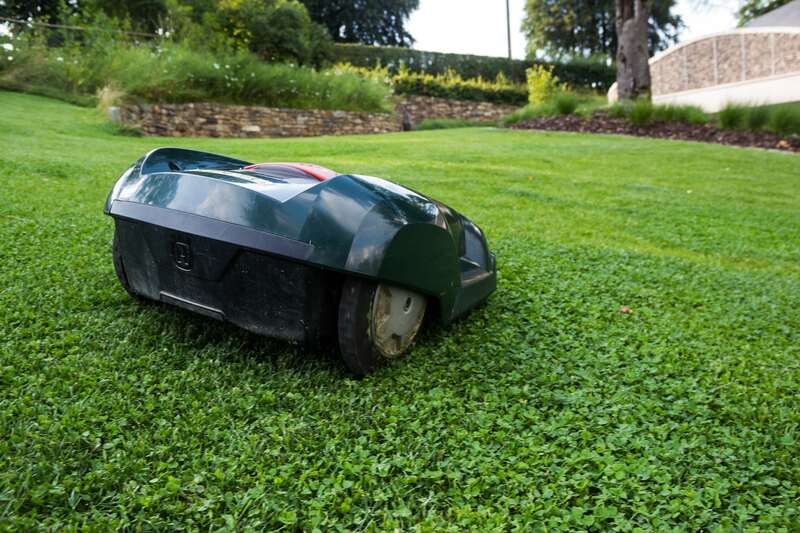
1972: S. Laurence Bellringer receives a U.S. patent for a new type of mower he called “The MowBot:”
SEE RELATED: How Do Robot Lawn Mowers Work?
Key features of the first robot lawn mower:
- No operator is needed.
- A boundary wire is sensed by the robo mower and it turns away.
- A battery provides the power.
- No fumes are created.
- No steering mechanism is used. A robot mower simply turns away from the boundary wire and moves in a different direction.
- No one has to be there to operate the mower. You put the boundary wire around the area to be mowed, turn in the battery, and let it work. Kind of like having servants mow the lawn while you sit in the manor house sipping tea.
The MowBot was followed by robot mowers that:
- Don’t need a boundary wire
- Can be programmed to map a path to mow
- Use solar power (1995: Husqvarna rolls out the Solar Turtle robo mower)
- Can run 24/7, recharging from the sun (Yes, you can mow your grass while you sleep. Robot lawn mowers are that quiet. They won’t wake you or your neighbors.)
- Can run in the rain (But don’t mow your grass in the rain with any type of lawn mower.)
2022: Toro introduces the GeoLink Solutions Autonomous Fairway Mower for golf course customers.
2024: Electric Sheep debuts its AI-powered lawn care and landscaping robot for commercial use.
Future of the Lawn Mower Business
According to the Market Analysis Report of Grand View Research, a global market research company:
- $10.2 billion of lawn mowers were sold in North America in 2022.
- The market will grow 6.4% per year.
- Forecast: $21 billion will be spent on lawn mowers in 2032.
There is a growing market in China and Asia:
- $31.2 billion of lawn mowers were sold around the world in 2022.
- The market will grow 6% per year.
- Forecast: $60 billion of lawn mowers will be sold in 2032.
What is the Best Lawn Mower for You?
The best lawn mower depends on the size of your lawn, your budget, and your preferred power source. Our lawn mower product reviews cover a range of lawn mower types and budget ranges. Each product review includes a buyers guide to help you sort through your options.
Overall Best Lawn Mowers (featuring a range of types)
Best Lawn Mowers under $200
Best Lawn Mowers under $300
Best Lawn Mowers for Small Yards
Best Lawn Mowers for Big Yards
Best Push Mowers
Best Self-Propelled Lawn Mowers
Best Mulching Lawn Mowers
Best Reel Lawn Mowers
Best Riding Lawn Mowers
Best Zero Turn Lawn Mowers
Best Gas Lawn Mowers
Best Battery-Powered Lawn Mowers
Best Electric Lawn Mowers
Best Robot Lawn Mowers
SEE RELATED:
How Much Does a Lawn Mower Cost?
How Much Does Lawn Mowing Cost?
DIY Lawn Mower Maintenance Guide
Buy a Lawn Mower or Hire a Lawn Care Pro?
The history of the lawn mower has been driven by technology, but you have a choice who pushes that mower. You could do it yourself, or hire someone else to push or ride a mower to keep your lawn looking great.
The history of lawn mowing also includes neighbor teens, sons caring for the lawns of aging fathers, and LawnStarter, which was founded in 2013. If you’d rather not break a sweat mowing your lawn, hire a local LawnStarter lawn care pro to mow, trim, and edge your grass. Get a custom quote instantly.
Or, you could go old school and rent a couple of llamas or sheep every week or two.
LawnStarter editor Sarah Bahr contributed to this report.
Main Image Credits:
Reel Lawn Mower: Peakpx / CC0 1.0
Rotary Push Lawn Mower: Peakpx / CC0 1.0
Riding Lawn Mower: Pexels
Robot Lawn Mower: Needpix
